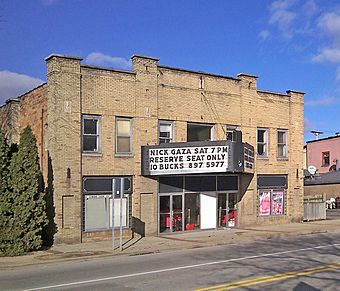Downtown Lowell Historic District facts for kids
The Downtown Lowell Historic District is a special area in Lowell, Michigan. It's mostly made up of old shops and businesses along Main Street (M-21). This historic district was officially added to the National Register of Historic Places in 1999 because of its important history and unique buildings.
Quick facts for kids |
|
|
Downtown Lowell Historic District
|
|

Strand Theatre
|
|
| Location | Roughly along Main St. bet. Hudson and Washington, Lowell, Michigan |
|---|---|
| Area | 15 acres (6.1 ha) |
| Built | 1904 |
| Built by | Morgan Lyon, Freeman S. Jones, Robert Graham |
| Architect | McDole Shaw, Colonel H. H. Vinton |
| Architectural style | Late Victorian, Art Deco |
| NRHP reference No. | 99001539 |
| Added to NRHP | December 9, 1999 |
Contents
A Look Back: Lowell's History
Early Days and Growth
The first European person to settle here was Daniel Marsac in 1831. He was a French fur trader. In 1835, Marsac bought land on the east side of what is now Lowell. He started a new settlement called Dansville.
By 1844, a bridge was built across the Flat River in Dansville. Soon after, a dam and a gristmill (a mill for grinding grain) were built. In 1850, Marsac sold his land.
Meanwhile, on the west side of the river, Arba Richards and Richard Wickham started their own settlement. They named it "Lowell" in 1854. Dansville and Lowell existed side-by-side. But in 1861, they joined together. They became the single village of Lowell.
Lowell's Business Boom
The 1850s brought a big increase in Lowell's population. The central business area grew quickly. Many mills opened because of the new dam on the Flat River. In 1858, the Detroit, Grand Haven and Milwaukee Railway arrived. This made it much easier to get to Lowell.
After the American Civil War, Lowell's businesses really took off. Farmers and mill owners had more money to spend. Over the next 30 years, many new commercial buildings were built. These often had multiple shops inside. Different kinds of businesses moved in. These new buildings were made of brick. They replaced the older wooden buildings downtown.
One famous merchant was Joseph Lowthian Hudson. He later started the well-known Hudson's department store in Detroit. He had a store in Lowell from 1888 to 1890.
Changes Over Time
After 1900, new styles of buildings appeared downtown. In 1904, a big flood washed away buildings near the river. A large fire in 1905 destroyed several more buildings.
However, the early 1900s also marked the end of Lowell's fast growth. The population didn't grow much for the next 80 years. Only a few buildings were built after 1910. This means downtown Lowell still looks much like it did over a hundred years ago!
What the District Looks Like
The Downtown Lowell Historic District covers both sides of five city blocks. It stretches along Main Street, on either side of the Flat River. The district has 56 buildings and structures. About 44 of these buildings help show the district's historic character.
Most of these historic buildings are one to three stories tall. They are made of brick or cement. They are commercial blocks, meaning they were built for businesses. There is also one brick house, the Graham House. This house is so important it's listed separately! There's also a wooden industrial building. Two bridges and the Jaycees Park are also part of the district.
Nearly all the buildings are right next to the sidewalk. Most of them were built between 1865 and 1890. Almost all were built before 1910. Many buildings show the Italianate style of architecture. But you can also see some Romanesque Revival and Art Deco buildings in the district.

